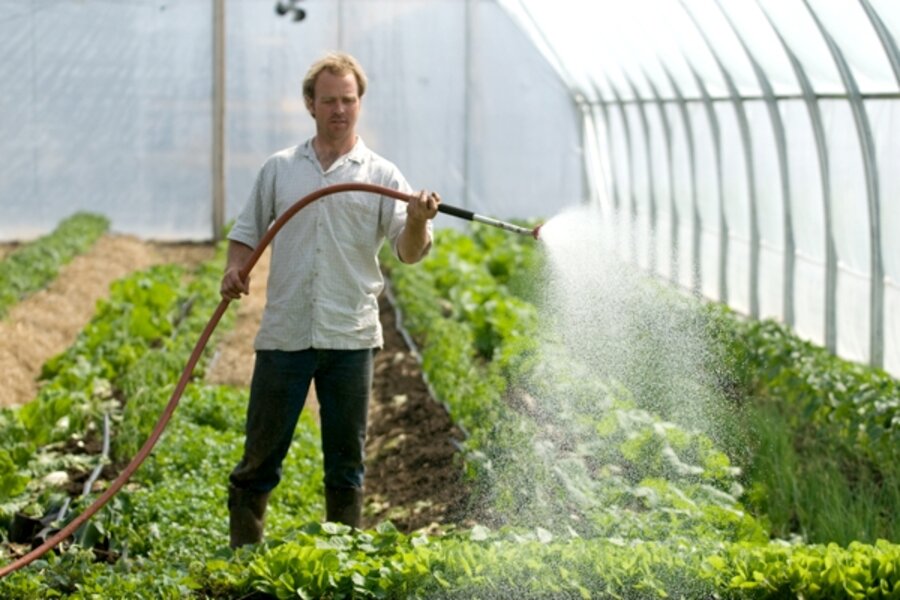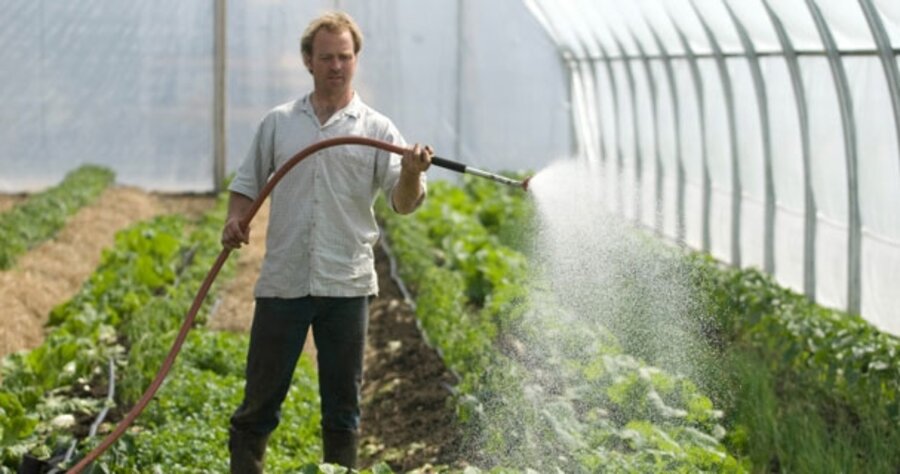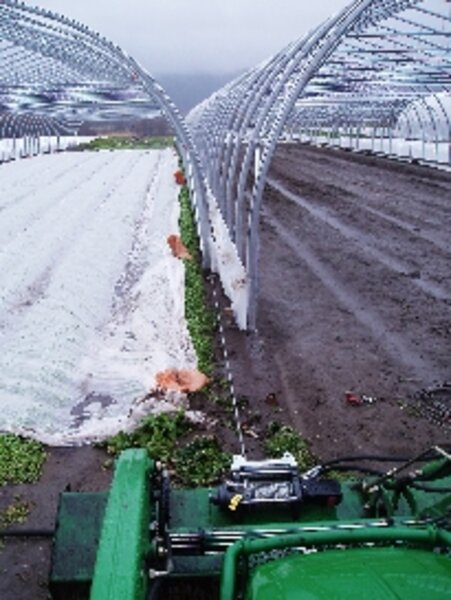Where imagination meets farming
Loading...
| Craftsbury, VT.
When Pete Johnson, a leader among New England’s organic farmers, set out one day last fall to pull an 18,000-pound greenhouse, in fits and starts, over a field-grown plot of lettuce, he inched forward an idea that could help make fresh local produce available year-round, even in Vermont.It was late October. For most of his fellow farmers, harvest time was over until spring. But Mr. Johnson was just revving up his tractor – and his dream.
He wants to extend the growing season into winter, and to start spring crops in late winter, in ground protected temporarily by movable greenhouses. Johnson had seen this done experimentally elsewhere. But he was trying it on a commercial scale, with greenhouses 200 feet long – twice the length of a basketball court and two-thirds as wide.
He had been warned the project could be risky with such big structures. But Johnson – a young, well-educated trendsetter – was willing to take that risk.
“It could blow over – or not move at all,” he said with a laugh as he climbed aboard his tractor. “But I’ve engineered it, and I think it will work.”
Johnson’s tractor was connected by steel cables to one of the front corners of one of his greenhouses. His facilities manager, Steve Perkins, sat at the wheel of a second tractor connected to the other front corner of the greenhouse. A chilly autumn wind rippled the lightweight fabric covering rows of salad greens. But even unheated, the greenhouse might protect plants enough to keep them producing through the winter: That was the idea.
The two men looked more like boys at play than men at work as they revved their engines. The buckets of the 3,500-pound tractors were tilted into the ground, braced against 9 tons of greenhouse steel plus friction.
“Really slow,” Mr. Perkins shouted above the rumble of the engines. The greenhouse frame groaned as the cable tightened. One side inched forward, the other side caught on a slight incline. Johnson jumped down, pried the frame up with a crowbar, and slid a two-by-four underneath. Each man stepped on the gas again, and both skids crept forward.
They coaxed the giant structure down the field for an hour – Johnson romping back and forth, checking the greenhouse alignment and propping more blocks under it. A drizzle turned to pelting rain. Neither man seemed to notice.
“I think if we just put something like ski tips on the front edges of the skids, that would do it,” Johnson said.
It was hands-on innovation in progress.
As fall gave way to winter, Johnson saw his vision vindicated. Through weeks of snow and some single-digit temperatures, Johnson supplied his community-supported agriculture (CSA) customers with fresh lettuce and other greens grown inside the unheated greenhouse. (In CSA consumers buy food directly from local farmers.)
Those plants stopped growing during Vermont’s deep January freeze (minus 30 degrees one week), but Johnson expects to start harvesting new growth in mid-February. “And that’s pretty cool to get fresh greens from unheated greenhouses all but one month of the winter,” he says.
• • •
Johnson built his first greenhouse 10 years ago, for a senior project at Middlebury College. Soon after, he put up a greenhouse on his parents’ property in Greensboro, Vt. He supplied salad greens to restaurants in Boston and New York, and he planned even then to move the greenhouse to extend his growing season.
But the pipe-and-plastic structure proved too flimsy. One morning Johnson looked out to see it flattened under a heavy snow. “It was a huge drag,” he says. “But then, in a couple days, I started seeing the possibilities.”
His inventive juices flowing, he designed a new structure to shed snow. He hauled a chain saw into the woods and cut trees for rafters and posts. During a January thaw, he finished the greenhouse in time to supply his accounts with early-season greens.
“It was the most creative thing I’ve ever done,” he says. “The design was all seat-of-the-pants, but it really worked.” The steep roof and high walls shed snow, letting in more warmth from the sun. When he could afford his own 230-acre farm – Pete’s Greens – in nearby Craftsbury, Johnson built another greenhouse just like the first. The sturdy logs, though, made the structure immovable.
Last spring the movable concept sprouted again in his imagination. Now with over 250 CSA customers, he bought four 35-x-200-foot greenhouses and erected them on steel skids. The plan was an attempt at something most people would have thought impossible in a northern climate until recently – harvesting virtually year-round.
“There’s a movement all around the country to extend the season,” says Lynn Byczynski, editor of Growing for Market based in Kansas. “It’s probably the biggest trend in small-scale farming in 50 years.”
Low-cost, low-tech “high tunnels” or “hoop houses” are popular in places as diverse as China and Europe, and among Amish farmers in the US. But Johnson is one of the first to grow salad greens year-round, Ms. Byczynski says. “It makes growers think, ‘If Pete can do it in northern Vermont, I can probably do it here.’ ”
• • •
Johnson is one of “a critical mass of new, innovative farmers” at the heart of “a massive wave of change,” says Dave Rogers, national policy director of the Northeast Organic Farmers Association. “Nationally, local food is mushrooming, and winter CSAs are developing all over the country.” He adds that even the US Department of Agriculture is getting the message: Last year’s farm bill designated $100 million for organic agriculture.
Johnson partners with other local producers to give them exposure and to diversify his own weekly offerings. Along with greens and vegetables, customers might get a bag of apples, sunflower oil, artisanal cheeses or breads, local wheat flour, eggs, or humanely raised meats.
The multifarm CSA is part of the local eating trend, an alternative to supermarkets. But isn’t local organic food expensive?
“Compared to what?” Johnson asks. “Compared to the absolute junkiest food you can buy in a supermarket? It’s too bad we think we can’t afford the most important thing in the world, when we’re so wealthy.”
For people who can’t afford local, organic food Johnson suggests home gardening as a way to save a lot of money and eat good food.
“It can be done in not a lot of time, and there’s plenty of land left in suburbia. You could have a neighborhood CSA,” he says. “Each person could grow five crops, and on Saturday everyone could bring their produce to someone’s garage – and talk to their neighbors, too.”
Pie in the sky? Maybe no more so than pulling a 200-foot greenhouse like a sled.
“What makes Pete unique is that he’s succeeding economically as well as practically,” observes Eliot Coleman, an organic farming expert in Maine whose small-scale experiments with movable greenhouses inspired Johnson’s. “He’s got the energy, brains, and imagination to try things nobody else is doing.”
Especially, maybe, the imagination.







